8:15 p.m., a thunderclap, the street lights go out, dark night.
The Klaus procession begins its course.
Beforehand, the Geisselchlepfer have thrilled the spectators with their skills.
And already the first of the up to 250 Iffelen scurry silently past. Gradually the triad blown by the musicians becomes audible. Between the Iffelen and the music, St. Nicholas walks with dignity, accompanied by Schmutzlis and torchbearers. The musicians are followed by the hordes of St. Nicholas hunters, about 1100 men, who swing their strings in a steady beat. It penetrates through marrow and leg! The end of the procession is formed by about 200 horn blowers.
History of the Klausjagen

The question arises again and again why Klaus is hunted in Küssnacht am Rigi? There are hardly any written sources that could prove the origin and age of the custom. For a long time it was assumed that our ancestors, who were still pagan at that time, had tried to drive away evil spirits and demons in a wild hunt with noisy instruments during the long nights of the winter solstice. By circling fruit trees with bells and by banging scourges, one hoped for richer yields at the next harvest. Folklore, however, has moved away from these interpretations, which in the course of time became popular beliefs. Recent publications find a root of the custom in northern French boarding schools of the early Middle Ages, where each time on St. Claus› Day a student was elected bishop and allowed to rule for one day. Over the centuries, this developed into wild goings-on that degenerated more and more into a carnival spectacle and led to frequent complaints.

For the Küssnacht authorities, too, the Klaus hunt became a nuisance, as the first mention of it in the minutes of the district council of 1732 proves: «Because of the boys who disturb the people by blowing their horns and trilling at night, it is recognized that with a pound fine they should no longer do such things in such an impetuous manner. The spirit of the times did not provide a good breeding ground for the old folk customs anyway. «Educated» Küssnacht residents were ashamed of the barbaric goings-on of some of their fellow citizens during the Klausen period. In 1837, for example, the district council wrote: «Concerning the so-called Chlausjagen, the same is forbidden once and for all, day and night, for minors and adults, namely for adults with 2 Neutaler fine, for minors with an appropriate corporal punishment». In 1888 the Klausjagen was again forbidden as disturbing mischief and the unauthorized shooting was punished with a fine of 30 francs. In 1914, even the pastor preached from the pulpit against Klaus hunting – again unsuccessfully.

Around 1920, the riots around the Klaustag took on increasingly violent forms. In order to avert the imminent danger of a definitive ban by the authorities, committed people from Küssnacht got together in 1928. They agreed to preserve the down-to-earth customs in a proper form, without non-traditional noise instruments such as tin cans and glass horns, and to celebrate the Klaus procession on December 5, 1928 in a dignified manner. In the following years, the work that had been started developed in a gratifying way. In 1933 the society, which in the meantime had become five years old, took on the form of a club. In 1933, 22 Klausjäger joined the society, which today, as the largest association in the district of Küssnacht, counts about 1800 male members.
Where the origins of the Küssnacht Klausjagen lie will probably never be conclusively clarified. Even if the roots do not go back to pre-Christian times according to the current state of knowledge, the unchanged living tradition is nevertheless an impressive 1000 years old.
Instruments
The Geissel
Long before the Klaustag, the Geisseklepfer get the village in the mood for the Klausen season. From the 2nd of November on, every evening in some corner of Küssnacht you can hear the bang of a Geissel. While the sheep whip roars slowly and dully through the streets, the bang of the carters› whip is shorter and higher.
What the two scourges have in common is that they are clipped with a stick and a tapered loop twisted from hemp. And they also have in common that they only bang impressively when the pinch (the end of the flagellar loop) moves at more than about 340 meters per second (the speed of sound).
Link with additional information about both scourges: priis-chlepfä Schwyz: https://www.priis-chlepfe.ch/index.htm
The sheep whip
Even the youngest in the village try their hand at the sheep scissor. To beat it requires not only skill but also strength, so that the loop is pulled horizontally from left to right through the air with both hands on the massive stick. The expert can be recognized by the fact that the scourge never touches the ground. It is tied individually, but also in formations, whereby of course the difficulty increases as the size of the group increases. Particular attention is paid to the formations with up to six Klepfern, which thrill the crowds on the main square before and after the main procession.
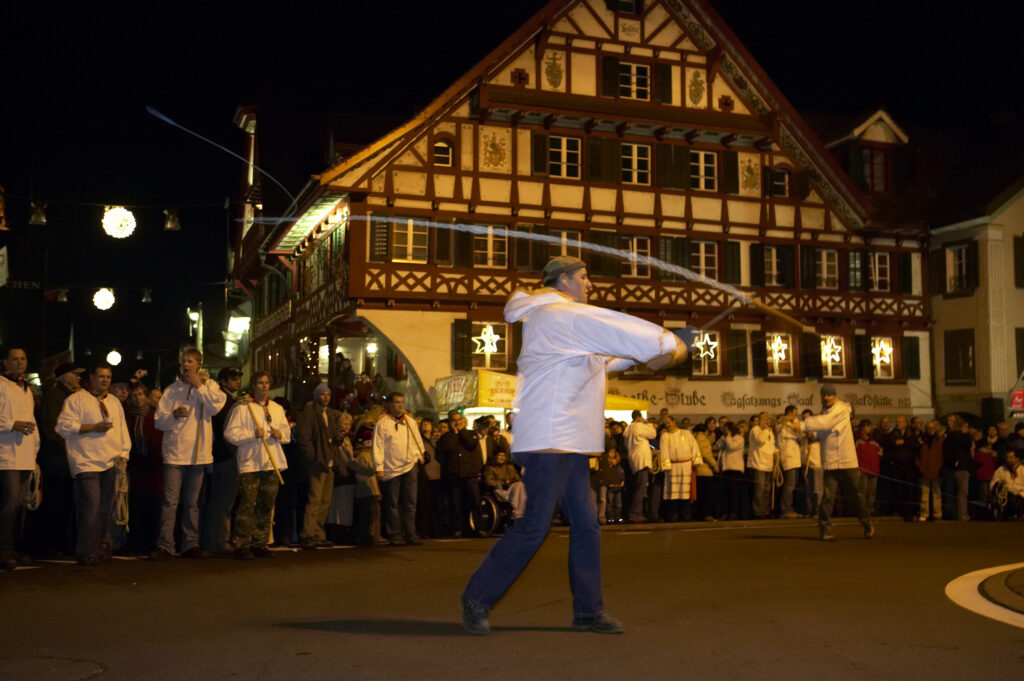
The Fuhrmans scourge
With the Fuhrmansgeissel it applies to klepfen the Chrüzlistreich. The knitter lets the loop fly over the head from back to front and back with one hand. The stick made of surgel wood is artistically decorated and elastic. To klepfen this scourge requires years of practice, special skill, strength and concentration. The game begins with strokes in quarter notes, which then change to eighth notes.
The Klepfer with the Chrüzlistreich open the procession through the village. In the darkened streets the spectators retreat from the invisible but loud bang. There is room for the Iffelen and the Samichlaus with his entourage.
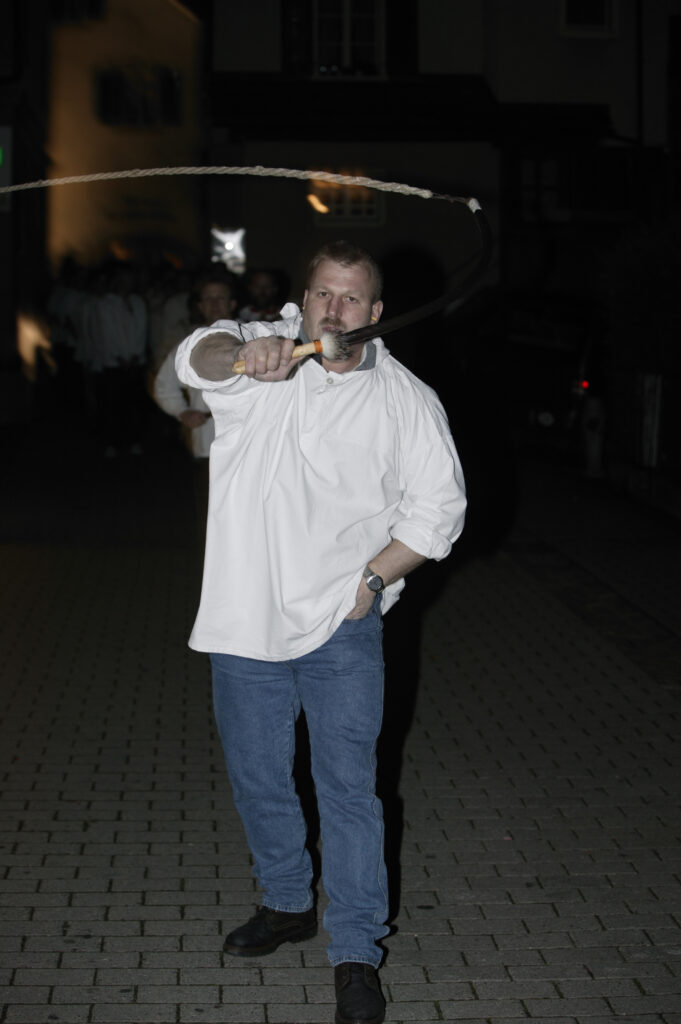
The Iffeles
With candles and rarely lit with lamps, figures in white robes scurry through the dark alleys. They prance around and get down on their knees in front of acquaintances. On their heads they wear an inful (iffele) that resembles the miter of a bishop. It seems as if illuminated church windows were wandering through the village.
It is not clear when the first Iffele were made. The oldest surviving works of art date from 1916 and 1917. Filigree patterns are pre-drawn on two large pieces of cardboard, then punched out and then double pasted with tissue paper. The smallest Iffele are not even 50 cm high, the largest specimens 200 cm and more! However, the Iffelen builders are not completely free with the motifs. On a Küssnachter Iffele belongs the figure of St. Nicholas in front and on the back a cross and Jesus inscription JHS.
Rosettes, ribbons, garlands and artistic images in all colors and shapes complete the picture.
Depending on the weather, the 200 or so Iffele are followed by St. Nicholas and his entourage: several Schmutzli and a dozen torchbearers.
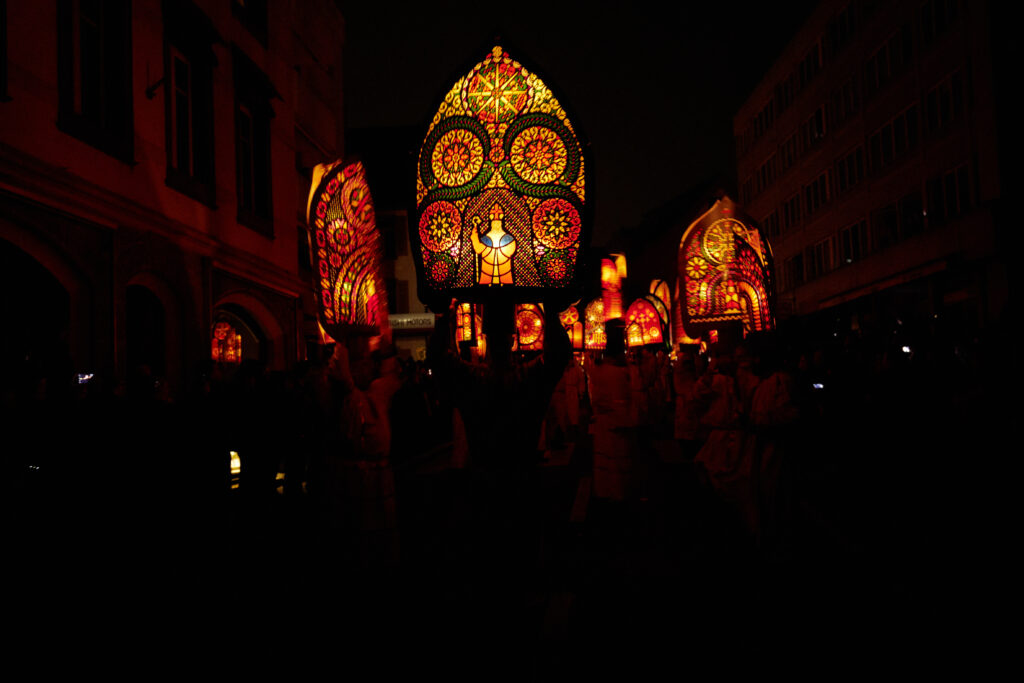
The music
The musical instruments are indispensable during the Klausjagen for playing the impressive Klausen melody. Without this triad the procession is unthinkable. The Klausen melody, which was composed by Josef Trutmann, has been played since 1912, but it only gained real popularity in the 1920s, when the people of Küssnacht added a mocking text to it. In unpleasant memory of the district mayor Klemenz Ulrich, called «Bodefridimänz», who during his term of office from 1920 to 1924 had several times vigorously intervened against the excesses of Klausjagen, people sang – and still sing today – to the simple sequence of notes: «Mänz, Mänz, Mänz! Bodefridimänz!» Today, this triad has become the trademark of the Klausjagen in Küssnacht.
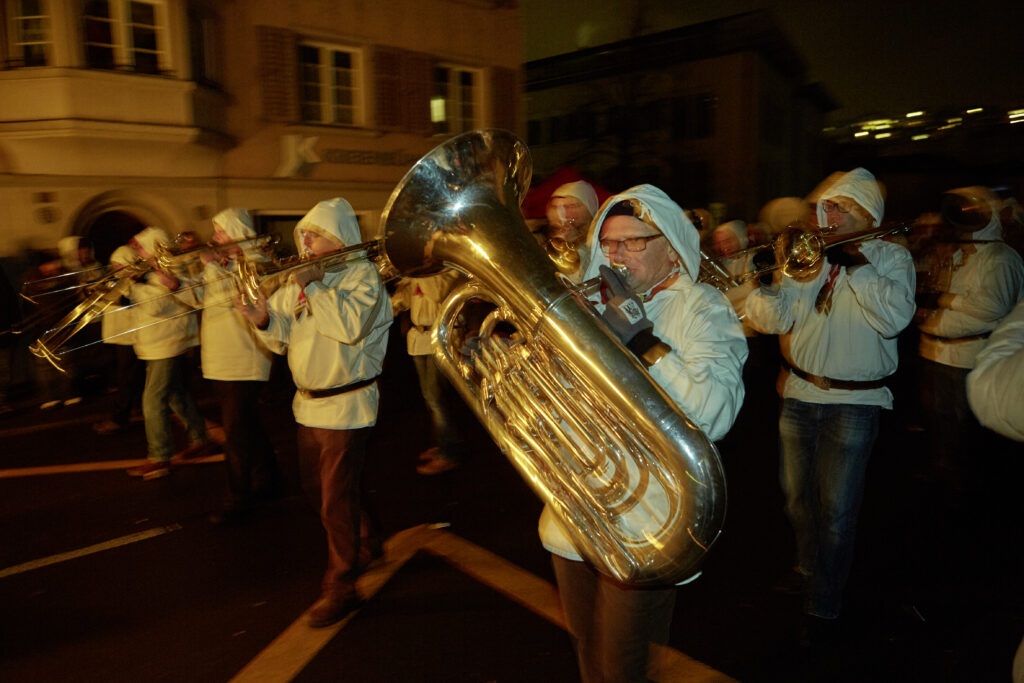
Sentencing And Knocking
Originally, simple cowbells were used for the Klausjagen. Later, large penny-cocks could be found in western Switzerland and in the Vorarlberg. Also in Küssnacht craftsmen tried to produce special senten for Klaus hunters. From the Muotathal come the knockers, which are conspicuous for their distinctive short tone.
Senten
Sentenges are the curved strings that take the beat of the music and have a bell-like sound.
For more information about the manufacture of the strings, visit the Swiss string manufacturers:
Beeler Metal Construction in Küssnacht
«Sonnailles» of the Aterliers Firmann S.A., Bulle
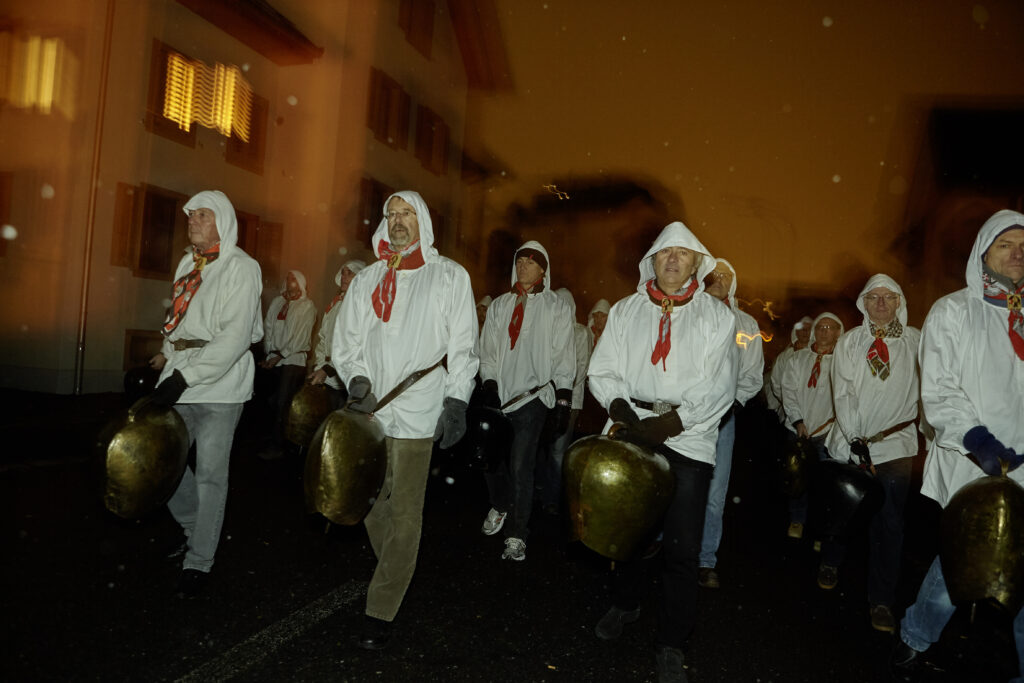
Knocking
Knockers are mainly frog mulbells made by Schelbert Glockenschmiede AG, Muotathal. These can be made by machine or purchased hand-forged. Sold by Arthur Weber AG, sizes no. 1-15.
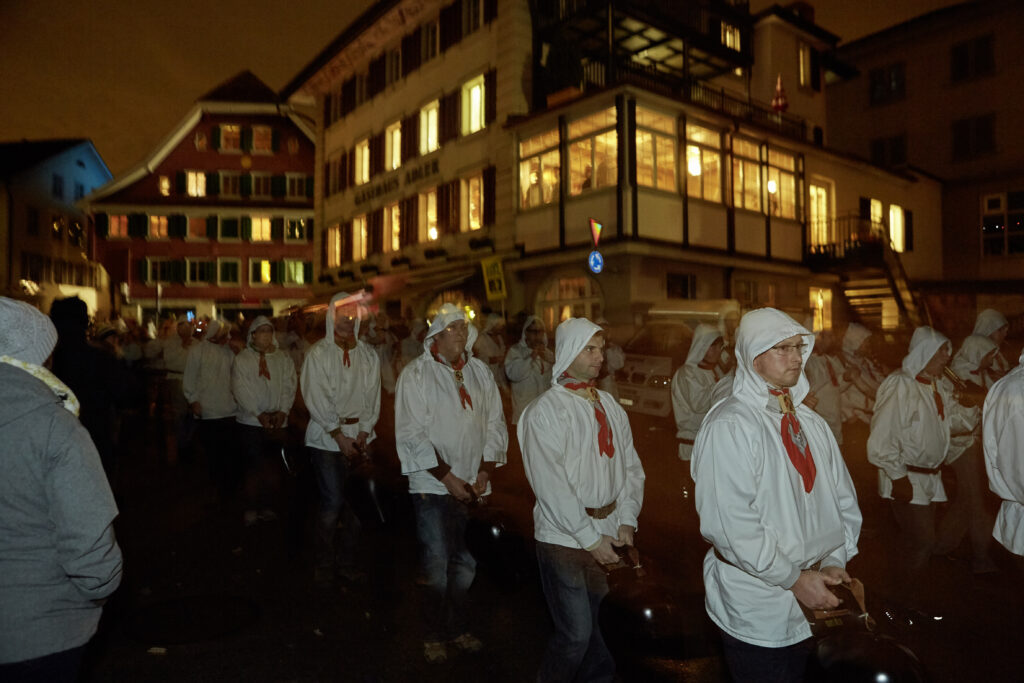
The horns
At the end of the procession follow more than 150 horn blowers. On cow horns they produce an eerily monotonous roar in an unwavering rhythm: twice short, once long.
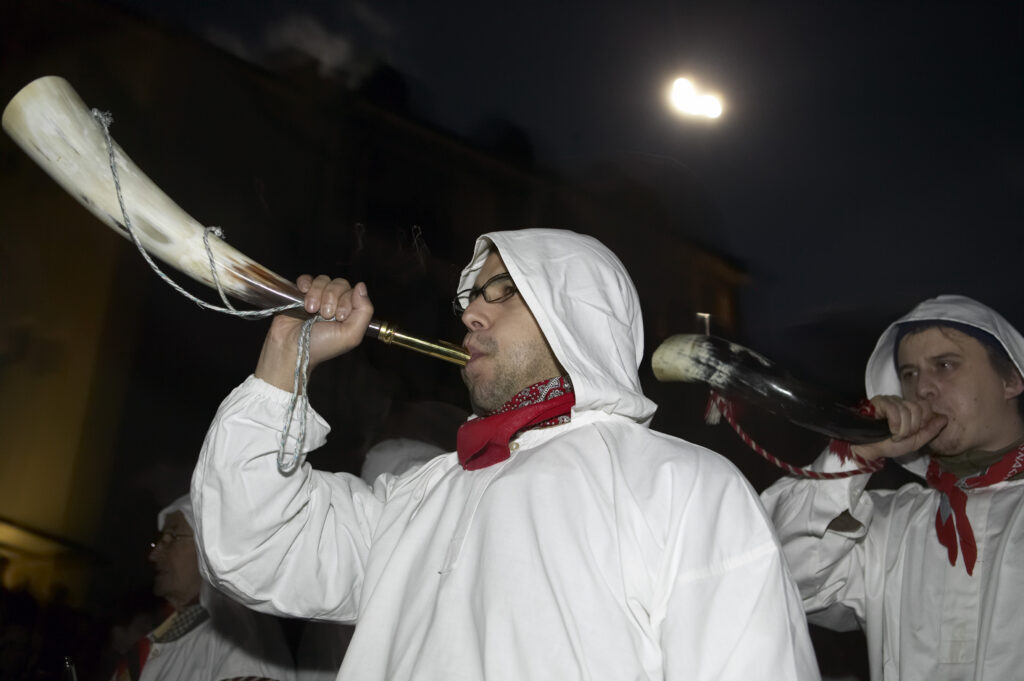
Klausjäger
titel «under construction»
under construction
